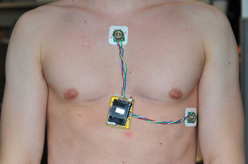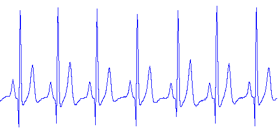A Wearable, Long-term Cardiac Monitor
- Category: Circuits & Systems, Medical Electronics
- Tags: charles sodini, margaret delano
We have developed an experimental cardiac monitor for long-term data acquisition and analysis. The monitor consists of a central printed circuit board (PCB) that contains one electrode and most of the electronics. Two additional satellite PCBs house the remaining electrodes and buffer circuits and complete the system. It consumes 7.3 mW and can record a single-lead electrocardiogram for over one week.
We based the long-term monitor prototype around a Texas Instruments MSP430 low-power microcontroller that enables high computing power with very low power consumption. The prototype monitor is mounted on standard 3M 2560 Red Dot electrodes (see Figure 1). The central board is fabricated on a flexible PCB substrate. Mounting the PCB directly on the electrodes improves the SNR by an estimated 40 dB compared to using wired leads[1]. The monitor has rounded corners to prevent prodding the wearer and is coated in parylene-C for biocompatibility and insulation. The monitor has a micro SD card on board, which is enough to store weeks of ECG data sampled at 250 Hz continuously and without compression (see Figure 2).
A clinical test was performed to validate the monitor. Participants (N = 6) wore both the experimental cardiac monitor and a commercially available monitor while engaging in physical activities such as walking, stepping, and running. QRS sensitivity and QRS positive predictability were determined for each ECG waveform. The monitor performed as well as or better than the commercial monitor in all interventions. It performed well even under high activity levels such as running and may be a viable alternative to commercially available monitors.
- Figure 1: The wearable, long-term cardiac monitor is attached to the chest with conventional 3M electrodes. In this configuration, the cardiac monitor measures a lead that mimics a standard Lead II ECG.
- Figure 2: A sample ECG waveform output by the wearable cardiac monitor while a subject is supine.
- A. Searle and L. Kirkup, “A Direct Comparison of Wet, Dry and Insulating Bioelectric Recording Electrodes,” Physiol. Meas., vol. 21, pp. 271-283, 2000. [↩]

